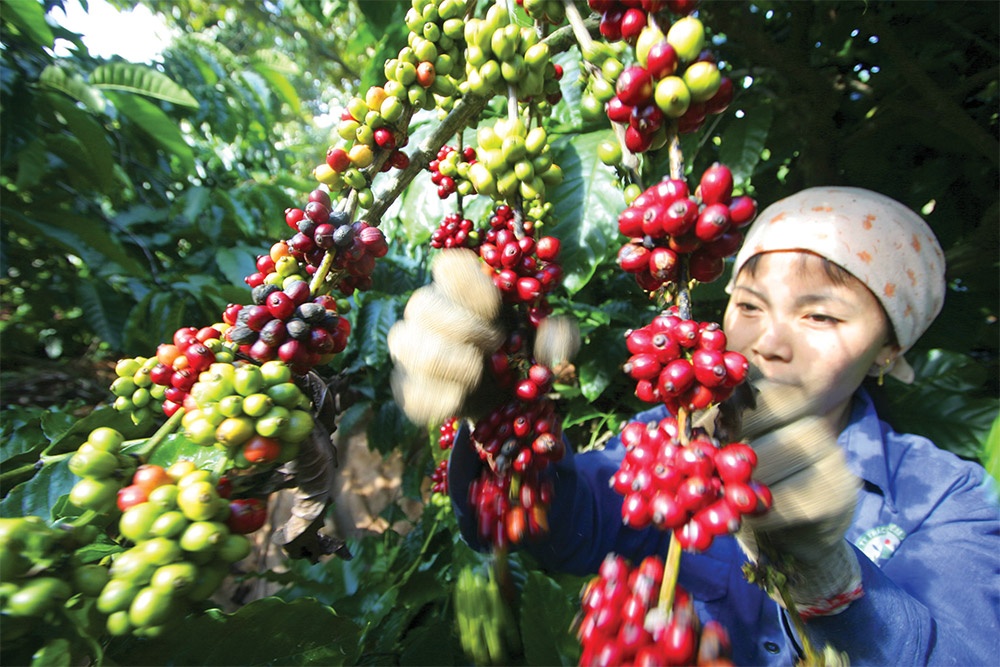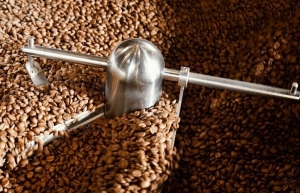Coffee arena gains from export prices
The country’s coffee industry achieved success in the past year, with exports reaching 1.24 million tonnes. Coffee was the third most valuable agricultural product after vegetables and rice, with an export turnover exceeding $5.2 billion, according to the Ministry of Agriculture and Rural Development (MARD).
 |
| There is still concern about demand for Vietnamese coffee, photo Le Toan |
The main reason for the success was a significant increase in export prices. Coffee was the agricultural product with the highest price increase among key export items in 2024, according to the Ministry of Industry and Trade.
In the first 11 months of the year, the export volume of coffee was over 1.2 million tonnes, a decrease of 14 per cent compared to the same period in 2023. However, the export turnover of coffee in the past 11 months increased by over 35 per cent thanks to record high prices.
In October, the average export price reached $5,720 per tonne, the highest in history, and increased by 59 per cent compared to the same period last year. In November, the price slightly decreased to $5,580 per tonne. On average, Vietnam’s coffee export price in the first 11 months of 2024 reached just over $4,000 per tonne, a 57 per cent increase compared to the same period in 2023.
Do Ha Nam, vice president of the Vietnam Coffee-Cocoa Association (VICOFA), said that 2024 was an unprecedented year for the industry in Vietnam and globally.
“The price of Vietnamese coffee is at a historic high, with robusta prices at times higher than arabica. On the London trading floor, the price of robusta coffee surpassed the $5,000 per tonne for the first time ever,” Nam said.
Despite the benefits of price increases for coffee growers, Le Duc Huy, chairman of Dak Lak 2-9 Import-Export, pointed out that the coffee market experienced significant price fluctuations amid global political changes. Therefore, farmers should sell coffee regularly according to demand, avoiding speculation or borrowing to hoard goods.
“Businesses also need to be more cautious in cost management and risk control. The coffee business today faces more challenges than before due to significant price fluctuations and increased financial costs. Companies need 2-3 times more capital to ensure inventory compared to previous years,” Huy said.
He also expressed concern about the decrease in demand for roasted Vietnamese coffee compared to last year, as some companies have switched to using robusta coffee from Brazil. However, he said that he hoped that by the beginning of 2025, the demand for Vietnamese coffee in Asia would strengthen and companies would prioritise using home-grown robusta.
Vietnam exports coffee to more than 80 countries and territories. Its biggest markets include Germany, Italy, the US, Belgium, Spain, Japan, the Philippines, Russia, China, and the UK. Nam of the VICOFA believes there remains much room for exports, which could bring home up to $10 billion in revenue in the future.
“To improve coffee’s added value, it is important to optimise free trade agreements with importing countries, step up advertising high-quality Vietnamese coffee, organise more trade promotion, and provide businesses with market information,” said Nam.
In the coming years, Vietnam will have room to export coffee to the EU thanks to being ready to comply with international requirements, such as the EU Regulation on Deforestation-free Products (EUDR) set for December 2025.
The EU is now the biggest coffee importer in the world, accounting for 33-35 per cent of global market share. The consumption of the market in 2024 is expected to reach $48 billion, and the figure may escalate to $58 billion by 2029. Therefore, any significant policy on imports will have a prompt impact on the coffee price.
“Under the EUDR, businesses won’t be able to export certain agricultural products, including coffee, to the EU market if they cannot prove that their products do not cause deforestation. Vietnam will have an advantage in exporting coffee to this market because coffee companies in Vietnam are ready to export products meeting EUDR requirements,” said To Viet Chau, deputy director of the International Cooperation Department under the MARD.
 | Vietnamese coffee industry sets new revenue record Crop yields between 2023-2024 marked a historic milestone for Vietnam's coffee industry, with export revenues reaching record levels despite a decline in production volume. |
 | Processed coffee in export expansion Processed and instant coffee for export is experiencing robust growth in both quantity and value at a time when raw material prices are at record levels and exports are decreasing in volume. |
 | Sustaining growth in coffee amid global shifts Global coffee markets are entering a pivotal phase, shaped by fluctuating prices, climate challenges, and evolving regulations. As Vietnam navigates these dynamics, Laleska Rossi Moda, analyst at Hedgepoint Global Markets, spoke with VIR’s Khanh Linh about its ability to sustain competitiveness and drive growth. |
What the stars mean:
★ Poor ★ ★ Promising ★★★ Good ★★★★ Very good ★★★★★ Exceptional
Related Contents
Latest News
More News
- Human-centred governance seen as key to AI development (December 19, 2025 | 18:19)
- Top 10 notable events of Vietnam’s industry and trade sector in 2025 (December 19, 2025 | 14:00)
- Tungsten surges to 12-year high as world enters a new 'black gold' race (December 18, 2025 | 17:27)
- Vietnam’s coffee exports set new record despite price pressures (December 18, 2025 | 17:13)
- Garment and textile sector seeks new growth after volatile year (December 18, 2025 | 17:01)
- VinSpeed and Siemens strengthen cooperation for high-speed rail development (December 18, 2025 | 16:53)
- High-tech adoption for TH true MILK (December 18, 2025 | 13:39)
- Takeda supports health resilience amid climate change challenges (December 18, 2025 | 12:39)
- Mondelez Kinh Do - a chapter of purpose-led leadership in Vietnam (December 18, 2025 | 09:44)
- VNPAY services receive the highest-level PCI DSS international security certificates for six consecutive years (December 17, 2025 | 23:47)

 Tag:
Tag:





















 Mobile Version
Mobile Version